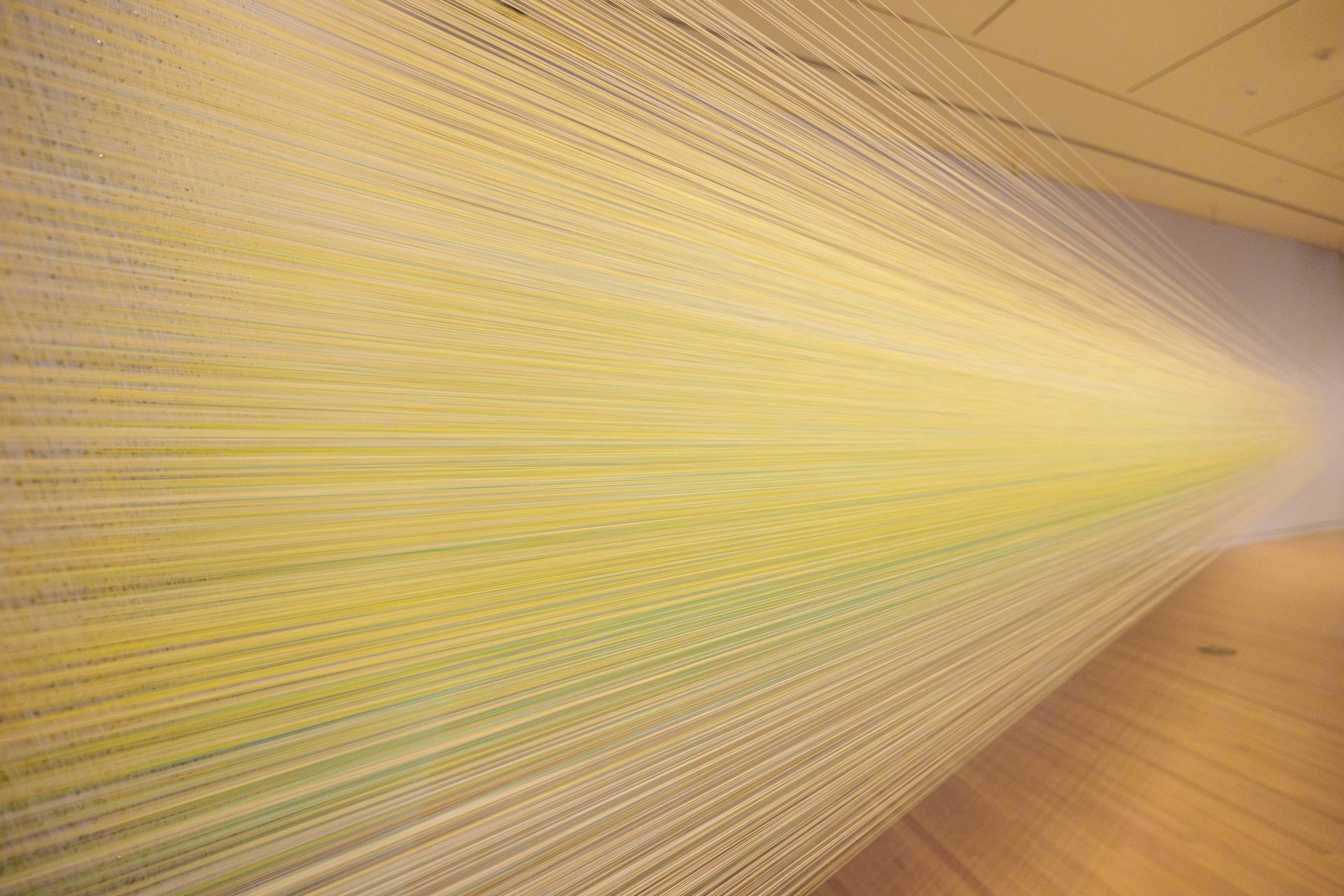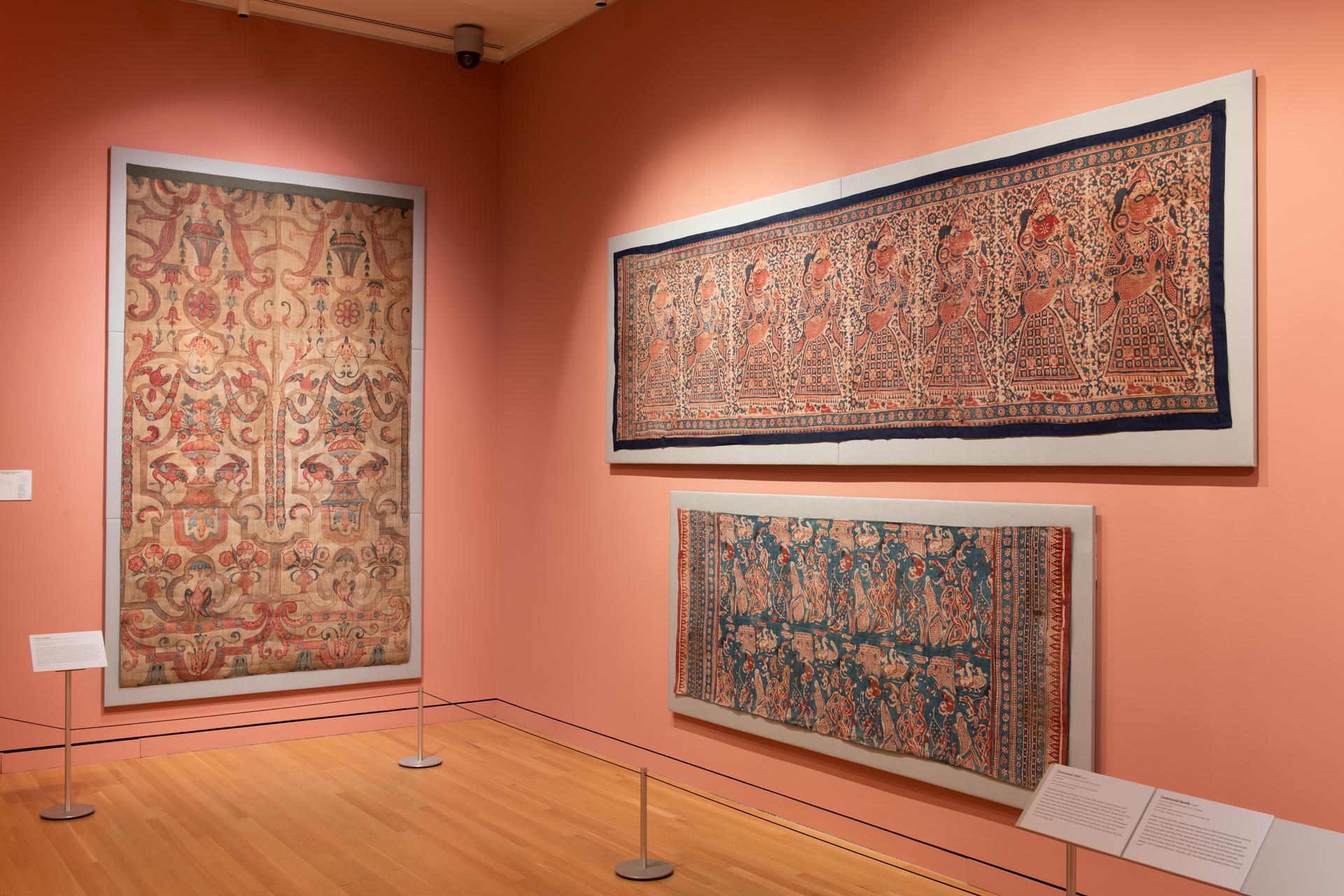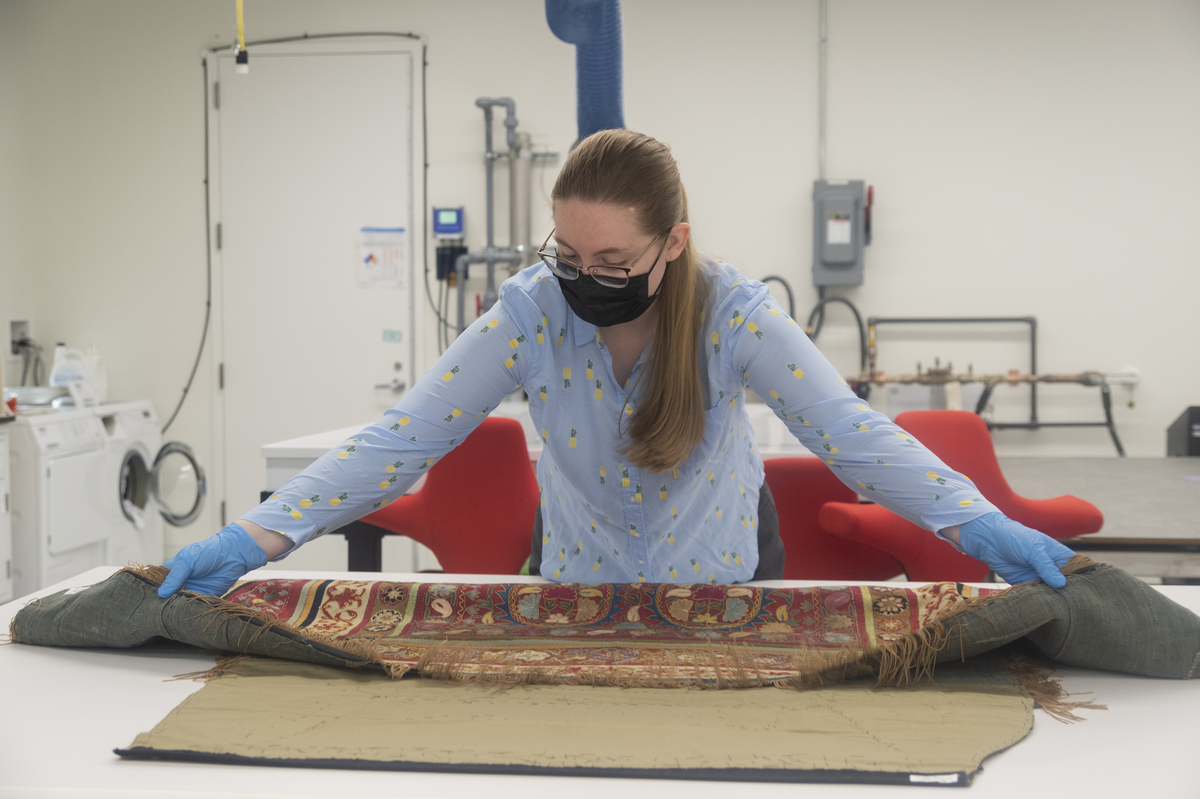Almost every faith tradition has a holy time in early spring, when budding trees and returning songbirds embody the cycles of sacrifice and renewal central to so many religious narratives. This year, Lent, Pesach and Ramadan briefly overlap in early April, which is also Earth Month—arguably a secular equivalent celebrating the “higher power” of the planet. At The George Washington University Museum and The Textile Museum this spring, a pair of linked exhibitions running through July 1 grapple with related questions: What does it mean to make contact with the divine? And how can art—creating it, viewing it, using it for a purpose—make that contact possible?
Lamps, pitchers, flowers and arches
The museum’s second floor exhibition, “Prayer and Transcendence,” takes these questions in a concrete, practical spirit. Humans attempt to contact the divine through prayer, and for practicing Muslims, that contact takes place within the confines of the prayer rug—the lushly patterned, symbolically rich object that serves as the worshipper’s sacred space, often a portable one. “Prayer and Transcendence” explores the prayer carpet’s role and its iconography through a selection of carpets dating from the 16th through the 19th century, originating in Turkey, Iran, the Caucasus, Central Asia, and Northern India.
Traditionally, Muslims are called to prayer five times a day and are required to perform ritual cleansing before worship. “The need to have a clean space for prayer is very uniform [across Islamic cultures], although how that clean space is created varies from culture to culture,” senior curator Sumru Belger Krody told GW Today.
The prayer carpet serves practically as a barrier between the ritually purified supplicant and the ground. It also serves symbolically as a reminder of that purification, of the goals of worship and of the transcendence it makes possible. And it may serve instructively, to show the user where to place their feet, knees, hands, and forehead and keep their mind focused on the object of prayer. A particularly intricate piece on display from the Metropolitan Museum of Art is woven with scriptural texts, reminding worshipers of key verses from the Quran and names of Allah.
“When you walk into the galleries the first thing you’ll see is these carpets do have a very directional design, and that’s created by the arch form you see in the center,” Krody said. The arch shape, emblematic of Islamic prayer carpets, mirrors the mihrab, an architectural niche in the wall of a mosque indicating the direction of Mecca. It also serves as an allegorical doorway to paradise, indicated by other imagery surrounding it. Some carpets’ arches are filled with floral forms, reflecting the Quranic conception of Heaven as a walled garden. Others are decorated with a long-necked pitcher shape, symbolic of ablution before prayer.
One of the most prominent motifs in prayer carpet imagery is the hanging lamp, which in the mosque symbolizes the light of divine presence. One evocative verse in the Qur’an describes the light of God as being “like a niche within which is a lamp,” lit by oil that “would almost glow even if untouched by fire—Light upon light!”
Divine light as metaphor for God’s presence is, of course, an image shared across many religions. Also on display in “Prayer and Transcendence” is a Torah ark curtain, or parokhet, in which the lamp shape features centrally, illustrating the cross-cultural currents that influenced religious art in the Middle East and North Africa.
Divine light
Upstairs, the museum has mounted a contemporary vision of the concept: “what color is divine light?”, a massive site-specific installation by artist Anne Lindberg. A broad ray of shimmering color stretching all the way across the third floor, the piece is composed of thousands of chromatic threads in contrasting colors that give it a hazy, indefinite quality at its edges. More than one visitor hesitated, concerned they might be about to touch it, while the closest thread was still more than a foot away.
Part of that effect is due to “impossible colors,” a neurological phenomenon arising when the brain attempts to “see” a transition between complementary hues. Since cone cells in the human eye can parse light’s wavelengths only antagonistically—black versus white, red versus green, blue versus yellow—the brain has no way of accurately registering Lindberg’s cloud of light blue and citron-yellow threads against lavender-painted walls. The overall effect appears “white,” but only briefly; in person, the piece seems to shimmer with shifting colors as the viewer’s gaze moves.
“Your eye is seeing the lavender wall through the thread and the yellow is airborne against it, and the thread is also fogged with layers of white,” Lindberg told GW Today. Those contrasts create the “optical condition” of impossible color.
Exploring "Divine Light" at The George Washington University Museum and The Textile Museum from GW on Vimeo.
“What color is divine light?” was developed in tandem with “Prayer and Transcendence” and inspired by an eponymous 1971 essay in which art historian Patrik Reuterswärd suggests that divine light can only be described as “similar to, yet far more brilliant and resplendent than, physical light.” For Lindberg, that suggested a light beyond the physical spectrum, an experience beyond what is describable.
“I’m interested in things you can’t give words to,” Lindberg said. It’s why she loves poetry—how “words themselves can be not understandable.” Something new arises between a color and its opposite, between a combination of words and their individual meanings, or between an object’s components and its whole. Hence the tightly packed threads of her installations, the rigorous parallel lines of her drawings and their paradoxically ethereal overall effect.
Accordingly, “what color is divine light?” anticipates and accommodates a variety of responses. On a recent morning, some visitors lay next to it, looking up like stargazers, while others sat quietly, perhaps meditating. Mats are available in the gallery, and museum programming in the space has included yoga classes, meditation and performances of music and poetry. A QR code even gives visitors access to a “sounds of the divine” playlist.
“I think there have been occasions where people walk into the room and start crying,” Lindberg said. “When something has a hum like that—a heartbeat, an internal rhythm—it can touch your own internal rhythm and prompt an emotional response.”
The effect on the viewer is particularly profound because “what color is divine light?” was created specifically for its environs. The way the form comes into view as a visitor nears it is part of its construction. “I describe it as stitched into the architecture,” Lindberg said.
The grand scale of the piece is also deliberate. “I always feel very small in the world, and I think that’s because I have a respect for and an interest in the power of nature,” Lindberg said.
Lindberg got that ecological consciousness early. Her mother was an artist, her father a professor of economic geography with a focus on renewable resources, and the family traveled often. After receiving her B.F.A. from Miami University, Lindberg thought she might go into museum collections or anthropology, but an internship with the Museum of Natural History took her in a different direction. She worked in the conservation laboratory, where she unpacked and registered a newly-received collection of textiles from West Africa—“diagramming the weave structure, photographing, drawing, counting threads per inch.” She loved the “musical” quality of the pieces—their composition from different widths of material, how they unfolded to make a variety of different types of clothing.
The internship “taught me that I loved what I was doing, but I wanted to be an artist to help me understand it,” Lindberg said. Many of her drawings still have that precise, scientific quality, like a zoomed-in photograph of an unknown garment.
She first began experimenting with large-scale thread installations during a residency near Ghent, New York, where she now lives. The spacious, cool light in the studio where she worked made her suddenly envision taking her drawings into three-dimensional space. “Rather than having them on a substrate or stitched in some way, what happens if they’re out in the air?” Lindberg remembered asking herself. “I made very, very crude experiments with just straight pins, but there was something there.”
Since then, Lindberg has received multiple awards, fellowships and grants, including a Painters & Sculptors Joan Mitchell Foundation Grant and a Charlotte Street Foundation Fellowship. Her work has been exhibited widely and is held in collections across the United States.
When it comes to divinity, Lindberg is more interested in unfolding questions than on nailing down answers. “I wasn’t really raised in any organized religion,” she said. But if anything makes her feel the presence of the divine, it’s the specifics of her physical world. “It’s everything from birds flocking to the [movement of] coffee grounds in my sink—things where there are particles in conditions that are influenced by currents in the air or the flow of water or light,” Lindberg said.
“Prayer and Transcendence” and “Anne Lindberg: what color is divine light?” are on view through July 1 at The George Washington University Museum and The Textile Museum. For more information about the exhibition, related programming and museum hours, visit museum.gwu.edu.




